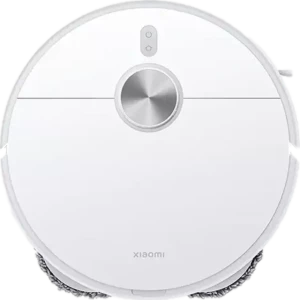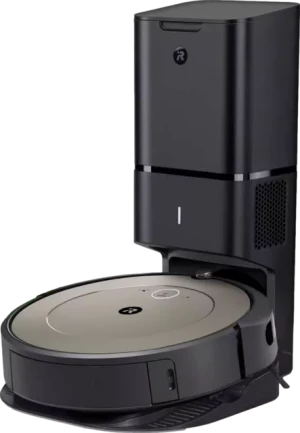The vacuum's ability to generate a map of its cleaning space is one of the commonly asked-for features. The map it creates allows the robot to keep a record of the layout of the space. Mapping and navigation can be used for different situations, e.g.
the Roomba i1 Plus having the mapping feature can provide efficient cleaning in the mapped-out areas keeping out of those that are not. The Xiaomi X10 Plus also has the mapping and navigation feature, navigation defines how the robot vacuum moves around the space. Mapping and navigation often go hand in hand to help the vacuum move to the mapped-out spaces to be cleaned ignoring those that aren't.
No-go zones is a feature found on many advanced robot vacuum cleaners and Roomba i1 Plus supports this feature. These zones are basicaaly digital boundaries or restricted spaces that you can set up to prevent the robot from accessing specific areas or rooms during its cleaning cycle. The Xiaomi X10 Plus also supports the no-go zones feature, such a feature is particularly useful in rooms where there are locations that you want to keep off-limits to the robot vacuum.
Many modern robot vacuum cleaners such as the Roomba i1 Plus are designed to work with Amazon Alexa, which means that they can be added to the Amazon Echo ecosystem and controlled using voice commands. The Xiaomi X10 Plus can also work with Amazon Alexa, keep in mind that you will need an Alexa-enabled device such as an Echo speaker for voice control to work with Xiaomi X10 Plus. The Roomba i1 Plus is compatible with Google Assistant, enabling you to control it using voice commands through Google Home devices or the Google Assistant app installed on smartphones and tablets.
The Xiaomi X10 Plus is compatible with Google Assistant, it's advised to verify the level of compatibility with Google Assistant before buying a robot vacuum. The Roomba i1 Plus has a period of 1 year, this typically range from 1 year to 2 years, however some higher-end models may offer longer warranty periods. The Xiaomi X10 Plus, at 2 year
has a longer warranty period than the Roomba i1 Plus with a difference of 1 year.
When thinking of buying a robot vacuum cleaner, it's important to read and understand the warranty terms and conditions, as well as any limitations or exclusions that may apply. Roomba i1 Plus's dustbin capacity is at 0.4L, dustbin capacity indicates how much dust, debris, and pet hair the vacuum holds before it requires to be emptied. Different floor types require a robot vacuum to be at a given ground clearance so as to optimize performance.
The Roomba i1 Plus adjusts its height to match this requirement, for example, it may raise itself slightly when transitioning to a carpet to allow for effective suction, and then lower itself on hard floors to make sure the brushes make good contact. Automatic height adjustment is commonly found in mid-range to high-end robot vacuum models such as the Xiaomi X10 Plus with sophiscated sensor technology and adaptability. This feature is essential for keeping up cleaning performance across various floor types, including carpets, rugs, hardwood floors, and tiles.
Most robot vacuum cleaners are equipped with sensors and indicators to alert users when the dirt collection container is full and needs to be emptied. Roomba i1 Plus supports this feature, which prevents the robot vacuum from getting clogged thus performance will be maintained as soon as the bin is emptied. Xiaomi X10 Plus also can indicate when its dustbin is full, for a robot vacuum to indicate that it's full can improve the convenience of owning one since it minimizes the need for constant monitoring.
The Roomba i1 Plus weighs 4.7kg, robot vacuums are generally designed to be lightweight and compact to easily get around and portability. Xiaomi X10 Plus, at 3.8kg
is lighter than the Roomba i1 Plus with a difference of 0.9kg. It's advisable to take in consideration the weight of the vacuum when getting a model, especially if you plan to carry it up and down stairs
Roomba i1 Plus has a width of 338mm, aslo known as its cleaning path width, is the width of the area that the robot vacuum can properly clean in one go.
The width of a robot vacuum is key as it can affect its efficiency and the time it takes to clean a space
The Xiaomi X10 Plus, at 350mm
measures more in width than the Roomba i1 Plus with a difference of 12mm. A wider cleaning path can cover more ground in a single pass, shortening the time it takes to clean a room. Roomba i1 Plus's height measures 92mm, here you are looking at the measurement from the bottom to its highest point.
Height is a key consideration, especially if you have furniture with low clearance in your home. Xiaomi X10 Plus, at 97mm
measures more in height than the Roomba i1 Plus by 5mm. When selecting a robot vacuum, make sure that the robot vacuum can fit under the furniture and navigate effectively in your living space without getting stuck or causing damage.
The battery power of a robot vacuum cleaner is important as it determines how long the vacuum can operate on a single charge. It is measured in milliampere-hours (mAh), Roomba i1 Plus's battery power is 1,800mAh
The Xiaomi X10 Plus, at mAh5,200
has more battery power than the Roomba i1 Plus with a difference of
A bigger capacity implies longer battery life which can be of advantage if you have a large space or if you prefer the robot vacuum to complete cleaning cycles with less interruptions to recharge. The operating time of the Roomba i1 Plus refers to the time the vacuum can clean continuously on a single battery charge before it needs to return to its charging dock for recharging.
Roomba i1 Plus's operating time is 1.25h
The Xiaomi X10 Plus, at 2h
lasts more than the Roomba i1 Plus with a difference of 0.75h
Always plan cleaning cycles around the vacuum's operating time to maximize efficiency and prevent "incomplete work" between charge intervals. Roomba i1 Plus has a charge time of 2.5h, the charge time of a robot vacuum cleaner refers to the amount of time it takes for the vacuum's battery to recharge fully after it has been depleted during a cleaning cycle. The operating power consumption of a robot vacuum cleaner refers to the amount of electrical power the vacuum uses while it's actively cleaning your home.
Roomba i1 Plus has a power consumption of 28W, power is typically measured in watts (W) and changes among different robot vacuum models based on several consuption factors. Xiaomi X10 Plus, at 55W
consumes more power than the Roomba i1 Plus with a difference of 27W. Lower power consumption can be more energy-efficient and cost-effective over time, but it may also affect cleaning performance, especially on carpets.
Roomba i1 Plus has a dirt sensor, these are designed to detect the availability of dirt, dust, or debris in the room being cleaned and based on their readings adjust the vacuum's cleaning behavior during cleaning cycle. You may want to consider buying either the Xiaomi X10 Plus or Roomba i1 Plus If you prefer the ability to automatically adjust the cleaning modes of the robot vacuum based on the level of dirt and debris in your room. Self-emptying bins or automatic dirt disposal systems like the Roomba i1 Plus, are modern robot vacuum models that have the ease of use feature to empty their dustbins automatically.
Also, Xiaomi X10 Plus is self-emptying, it's important to note that self-emptying robot vacuums tend to be on the higher end of the price spectrum due to this advanced feature. This feature allows you to instruct a robot vacuum to focus on cleaning a particular spot in your home, Roomba i1 Plus supports this, which can be really useful for dealing with particular area messes or high-traffic areas. The Xiaomi X10 Plus also supports this feature, the spot cleaning feature is a convenient way to deal with specific area messes or high-traffic areas without running a full cleaning cycle for your entire space.
Roomba i1 Plus supports a smartphone app, through which you can control and monitor the vacuum remotely through your smartphone or tablet. Both the Xiaomi X10 Plus and Roomba i1 Plus have mobile application support, this enhances your experience by providing convenience, and ease update of features and functionalities. This feature in robot vacuum cleaners is designed to reduce the chance of the robot vacuum becoming stuck during cleaning.
Robot vacuums such as the Roomba i1 Plus are equipped with various sensors and technologies to navigate around obstacles and avoid getting trapped, however the effectiveness of this feature can vary among different models. Both the Xiaomi X10 Plus and Roomba i1 Plus have the "anti-stuck" feature, but clearing clutter, ensuring proper cable management, and creating clear paths for the vacuums can help further eliminate the chances of getting stuck while cleaning. These virtual barriers are typically set up and controlled via the robot vacuum's mobile app, similar to no-go zones, these barriers are setup to help you control and restrict where the robot vacuum can and cannot go while cleaning.
Both Roomba i1 Plus and Xiaomi X10 Plus support virtual barriers, the ability to set virtual barriers is mostly useful for homes with areas where the robot vacuum may encounter obstacles. Roomba i1 Plus has a route mapping feature which enables it to generate a map of your space and schedule efficient cleaning routes. This mapping capability improves the vacuum's ability to work effectively and systematically.
Route mapping is an important feature as it makes it possible for robot vacuums such as the Xiaomi X10 Plus to adapt to the layout of your home to work more efficiently and reduce the risk of missing certain spots. Voice prompts refer to notifications that the vacuum emits to provide you alerts on the different states of the vacuum. Roomba i1 Plus supports this feature
Xiaomi X10 Plus also supports voice prompts, this feature is useful for you who like audible notifications or users who have visual impairments.
Auto-docking is a feature in robot vacuum cleaners that refers to the vacuum's ability to autonomously return to its docking station when predetermined conditions are met such as getting work done, battery running low, or any malfunction. Both Xiaomi X10 Plus and Roomba i1 Plus support this feature, considered a convenient feature because it ensures that the robot vacuum maintains its charge and readiness for cleaning without requiring manual intervention. Most robot vacuum cleaners such as Roomba i1 Plus come having an "cliff detection" feature.
This feature is designed to prevent the robot vacuum from falling off stairs, ledges, or other elevated surfaces, ensuring its safety while cleaning. This safety feature that is also available on the Xiaomi X10 Plus is essential in preventing accidents and keeping the robot vacuum from damage. It gives you peace of mind knowing that the vacuum will not fall down a flight of stairs during its cleaning cycle.
Roomba i1 Plus has this convenient feature, which enables you to set certain days or times of day for the robot vacuum to start working. The scheduling feature in robot vacuums is specifically useful in keeping a consistently clean home with little or no manual intervention. Xiaomi X10 Plus too can be scheduled.
Roomba i1 Plus supports Wi-Fi, Wi-Fi-enabled robot vacuums offer several advantages and features, such as remote control, mobile app integration, voice assistant compatibility, and remote monitoring. Also, Xiaomi X10 Plus supports Wi-Fi, Wi-Fi connectivity improves the ease and flexibility of robot vacuum use, allowing for more efficient and customized cleaning routines.

